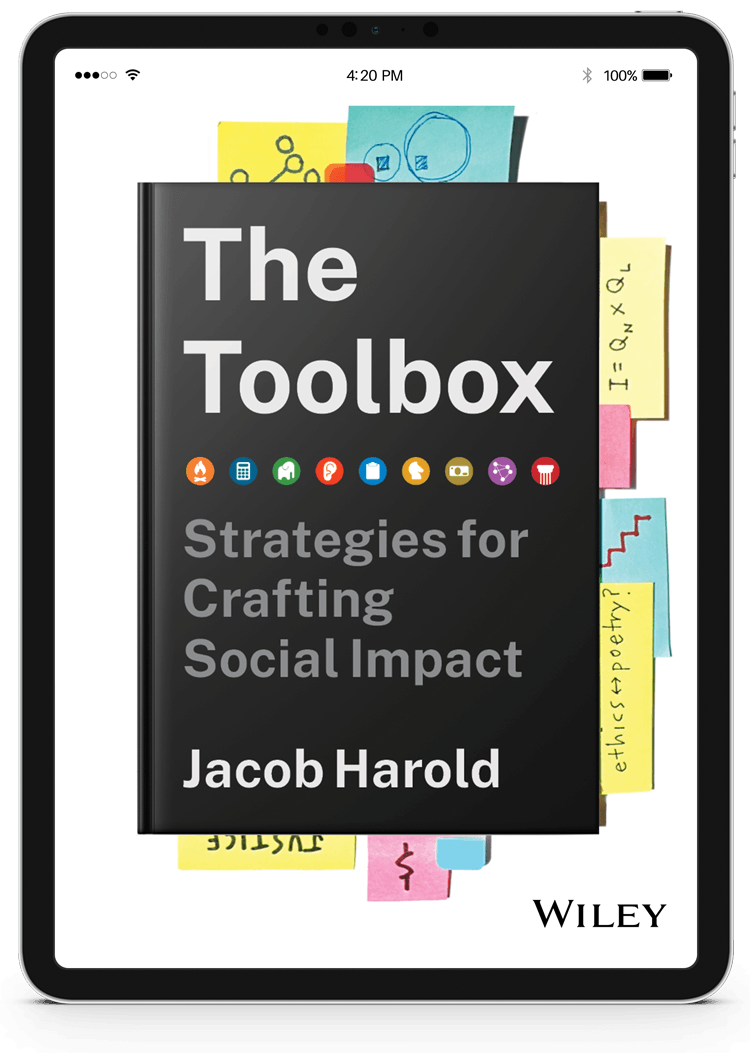What we need to help us build a better world

Storytelling
Some narratives are modest in scope—the assumptions a community makes about its park. Others are immense—the myths that create the substructure of entire societies.
In social change, we are trying to define new pathways toward a better world. For this reason, storytelling is an essential tool for anyone with a dream of something better.
Mathematical Modeling
Mathematical modeling can help us plan for the future and learn from the past. The rigor of math, applied to social change, ensures clarity, keeps us honest, and helps us imagine what is possible.
Sometimes math is simple counting, which can be morally invaluable. It is also strategically essential. We can use mathematical equations as metaphors, stories to help us explore an uncertain future.

Behavioral Economics
As social change agents, we must deal with the human mind as it is, not as we wish it to be. This chapter will explore how social change agents can navigate the dynamics of the human mind.
We’ll start with ten biases and then building on those biases are seven illusions—broader phenomena where conscious understanding often misses a deeper truth. The next section offers five solutions, effective ways to respond to the reality of the mind as it is. We’ll focus on interventions that change the context of human behavior.
Design Thinking
Vision is one of the prerequisites for social change. It is the mechanism by which we imagine a better future. But vision can be its own kind of ignorance; it can prevent us from acknowledging what is right before us.
Accordingly, we need ways to protect against the arrogance of our own perspectives and to reveal the insights that might be hidden in the people and the world around us. That takes intention, and that intention is captured in the spirit of design thinking.

Community Organizing
The very phrase “community organizing” reveals a paradox. “Community” is that most ineffable and human of substances: entwined threads of place, language, and history. Yet “organizing” suggests rigid lattices and strict hierarchies; it describes attempts to impose order upon disorder.
At its best, community organizing does both. It is the art of finding order in the common interests, angers, and hopes of a group of human beings. It is not the only such discipline. Others do the same in different contexts, such as management, teaching, and coaching. What separates community organizing is its focus on power.
Game Theory
We will not win alone. Much of this book has been about the building blocks of collaboration, such as transparency, kindness, logic, humility, adaptability, trust, and clear communication. Collaboration is a necessary ingredient of social change.
This chapter starts with three of the basic dilemmas of game theory. Then we’ll look at five ways to transcend these dilemmas. We’ll find lessons from nature, agriculture, and ice cream. Throughout, we’ll explore how these tools can help us chart a path to the social good the right way, the only way—together.

Markets
For better and for worse, markets organize much of human exchange. Some argue that markets are the engine of prosperity, a magical machine of exchange and growth. Others claim that markets are an amoral fount of inequality and environmental destruction. The evidence would suggest that both are correct.
In this chapter, will look at how market mechanisms can be tuned for good and how social change agents can tap into that power. And, importantly, we’ll explore how markets can fail us and how much of the work of social change is cleaning up the messes left behind by the wild horses of the market.
Complex Systems Science
Most social change is systems change. School system reform is—literally—about reforming a system of schools. Confronting climate change is about addressing how economic systems impact ecological systems. The very concept of structural racism rises from a recognition that injustice is built into systems.
This chapter explores many dimensions of systems, interaction, and complexity. We will start with a simple question: what is a system? Then we’ll look at the elements of systems and the characteristics of complex systems. Throughout, we’ll see how we might change the existing systems of the world and also build new ones.

Institutions
Institutions are patterns of relationship. They are lasting structures for how people connect, conflict, align, and entwine.
In the work of social change, we find ourselves in constant interaction with institutions. They are an essential context for our work. We have to work within and through them. Sometimes they are a target for our work; we are trying to change the behavior of an organization or a group of people. And very often, they are a vehicle for our work; they provide the structure for what we do.






